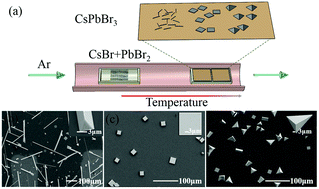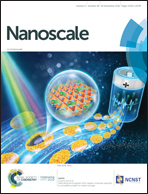All-inorganic perovskite CsPbBr3 microstructures growth via chemical vapor deposition for high-performance photodetectors†
Abstract
Perovskite cesium lead halide (CsPbBr3) has attracted considerable attention due to its excellent optoelectronic properties and superior stability against moisture, oxygen, light, and heat. In this work, the micro-environment controlled chemical vapor deposition (CVD) method has been adopted to synthesize high-quality single-crystalline CsPbBr3 microstructures, including microwires, microplates and triangular pyramids. Moreover, the structure–activity relationship between the material microstructures and the device properties is illustrated. The results show that photodetectors based on a single horizontal CsPbBr3 microwire exhibit a high responsivity (312.2 A W−1) and a fast response time of 5.8 ms. Photodetectors based on a single CsPbBr3 microplate exhibit a responsivity of 1.74 A W−1 and a response of 10 ms. These results indicate that the CsPbBr3 microwire photodetector is characterized by a higher photodetector performance when compared to the microplate due to its excellent crystallization quality and the Fabry–Pérot cavity effect in the microwire. Furthermore, the flexible CsPbBr3 microwire photodetector was demonstrated on a mica substrate. The results show that the photocurrent can be maintained at 90% after 3000 cycles at a bending radius of 2.5 mm. This work demonstrates the structure–activity photodetector performance, which is essential to develop a full understanding about high-performance optoelectronic devices based on all-inorganic lead halide perovskite materials.



 Please wait while we load your content...
Please wait while we load your content...